
Mark Tallent, international product manager for lighting and building controls at Crestron talks to Installation about trends in the lighting market.
To what extent has your part of the lighting market been affected by the growth of LED lighting?
The influx of new LED products has caused a major change in the controls market. Often LED fixtures and fittings do not have the same dimming performance as halogen or incandescent lamps. Customers request or specify the latest technology but are left dissatisfied – to combat this Crestron have launched the compatibility test programme. This enables specifiers, customers and manufacturers to send Crestron their products to test and report on the performance of the LED in combination with Crestron dimming control. This guarantees that there are no items left to chance when products are specified together and the customer knows what they are purchasing.
We have also, inevitably, seen the luminaire market continue to develop. At Crestron we found ourselves being the first point of contact when LED dimming issues occurred on our projects. The common issue tended to be that lights were not dimming smoothly; flickering was occurring. After a considerable period of R&D, we developed our own LED (CLED) range of innovative range of LED luminaires that replicates the smooth dimming curve, colour temperature and lumen output of halogen, with a 70,000-hour lamp that exceeds most comparable low energy fittings. The luminaires include a five-year warranty and two years on the PSU and have proved to be very popular with our dealers so far.
What are the common pitfalls that people need to avoid when specifying, installing or using your products? What advice would you give to avoid these pitfalls?
It is always important to look at the human element of the system – the people using the hardware, and the level of programming needed to achieve what they require from the system. Do they simply want to be able to manually dim the lights, or do they want to have a selection of pre-set lighting scenes to choose from? Do they want to be able to also control them from a mobile device? The options are endless.
Ideally lighting control should always be considered at the beginning of any self-build project. By deciding where the lights need to be at an early stage, you can plan well in advance for the appropriate number of fittings and control options as well as early planning of where the required cabling will need to be installed. Anything is possible, but if the room’s function and how the lighting system will be used are not taken into account at the start of the project, it becomes a much longer process.
Tell us about a recent lighting project that your company has been involved in.
We are very proud of a particular project in Dubai – a stunning villa with full Crestron HD audio & video, lighting and heating controls throughout, including the 55,000sqft garden! The Crestron lighting control system operates over 300 lighting circuits in the complex. With a simple button press on any lighting keypad or touch screen, the homeowner can instantly recall saved lighting scenes. New scenes can also be created quickly and easily via the iPad and Android mobile app.

There is even full lighting control, audio distribution and complete control of the swimming pools, Jacuzzis and basketball court.







